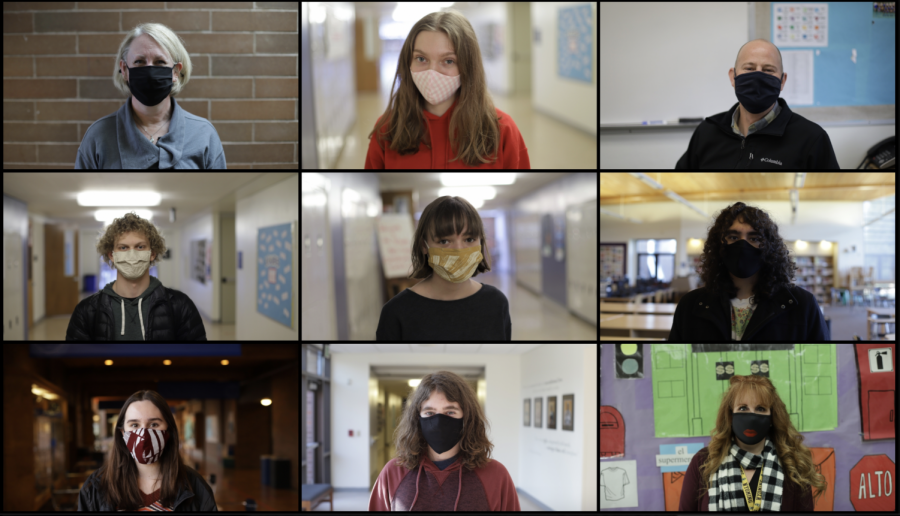From Flair to Functionality, Staff and Students Share How They Choose Their Masks
Masks have offered people with new opportunities to express their personal style.
March 31, 2021
Since the beginning of the COVID-19 pandemic, wearing masks in public and group settings has become an everyday practice. At La Salle, masks are required at all times with the exception of when seated for socially-distanced lunches.
Here are the mask-wearing preferences and experiences of nine members of the La Salle community:

Junior Keaton Bright owns “probably a couple thousand [masks],” he said.
His collection is made up of 50 reusable masks and about two dozen boxes of disposable ones.
“I’ve been trying to use more surgical style ones because A, they’re safer and B, for me it’s mostly about making others around me feel safe,” he said.
Using reusable masks is “the better thing to do,” Bright said. “You take the surgical mask and they just end up in the trash.”
Bright’s least favorite part of wearing a mask “is pretty much everything that isn’t making others feel safe.” Bright wants to respect the health of his peers, so he chooses to wear a mask, but they exacerbate his headaches.
Bright typically purchases his masks online from online websites like Amazon. He prefers sticking to masks that are simple and come in the shades of black or white.
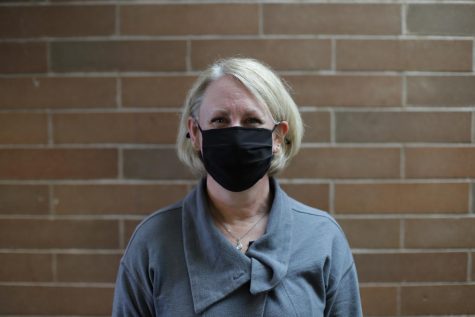
When wearing a mask, Spanish teacher Ms. Lisa Moran dislikes it “when I try to breathe in and the cotton goes in my mouth,” she said. To avoid this “when I’m teaching, I wear an N-95 [mask] that has more of a structured feel to it so that my mouth can move easier and I can project and talk easier.”
Outside of the classroom, Ms. Moran “like[s] the feel of the cloth masks against my skin,” she said. Her favorite brand of mask is Athleta. “They’re the most comfortable, they have a nice nose piece, [and] they look good,” she said.
To avoid having to coordinate her mask with her clothing, Ms. Moran only purchases masks in solid and neutral colors.
Overall, Ms. Moran thinks that her masks are “comfortable, [and] they keep me warm in the winter,” she said. “I don’t feel like they’re restricting to me.”

Senior Victoria Azar owns four masks. “I wear different ones for sports than I do for school,” she said. Azar is currently on the La Salle track and field team and is a Resolute Track Club member.
Azar incorporates her mask choice into her clothing. “I’m literally wearing a gingham mask right now,” she said. “I totally put it into clothing.”
When Azar buys masks, she looks for ones that “aren’t scratchy and [they’re] not too big,” she said. She buys her masks at Target or online.
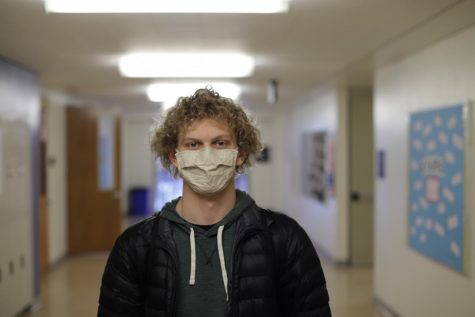
Many of senior Zach Williams’ masks are from Old Navy, “because they’re cheap,” he said.
When asked how many masks he owns, Williams said, “An uncountable number … literally hundreds.”
Williams chooses what mask to wear based on “whichever one is on top of the clean pile,” he said. “Sometimes [my mask and clothes are] accidentally similar colors.”
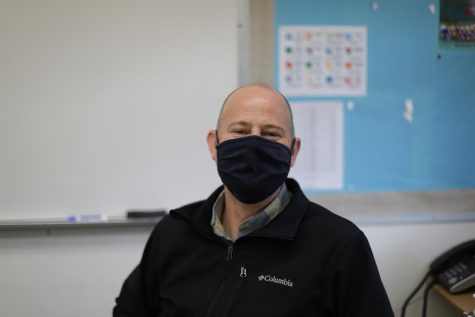
For English teacher Mr. Paul Dreisbach, choosing which of his 10 masks to wear is determined by where he is at the time.
“I have some masks that would not be appropriate for the classroom because of the political statements that they make,” Mr. Dreisbach said. “I also have masks that I wear at school that are more comfortable for me than masks that … I’m only going to be wearing for a short period of time.”
When choosing a mask, “I want to make sure it form-fits well, [and] that it’s big enough that it feels like it’s doing its job,” he said. The fit of his masks is especially important because “now that I’m teaching I want to make sure it stays up since I have to talk so much,” he said.
To support small businesses, Mr. Dreisbach has purchased some of his masks through Etsy. He also has a friend who regularly makes him homemade masks.
“I think I made one purchase of masks, way back in March of last year,” he said. “Since then, I’ve been relying on that gift of strangers and a couple [of] minor purchases on Etsy.”
Mr. Dreisbach’s biggest struggle with masks is that “I don’t smile very well with my eyes but I still smile a lot as a way of saying hello to people,” he said. “I realize how often I’m smiling at someone and not saying a word at them, but looking at them, and they must think ‘What’s this weirdo doing?’”
Mr. Dreisbach also finds that wearing masks “dulls the sound just enough that sometimes it’s hard to hear,” he said.

Senior Isa Sale rotates through a collection of about five or six reusable masks. To pick which she will wear on a certain day, she typically goes for “just which ones are clean or whatever I’m feeling that day,” she said.
In a quest to buy masks in a way that supports the community, Sale and her family found and bought from a “Black-owned shop this summer that made handmade masks,” she said.
Sale dislikes “not being able to drink in class” because of the masks as well as “not being able to hear people when I’m trying to talk to them in class,” she said.
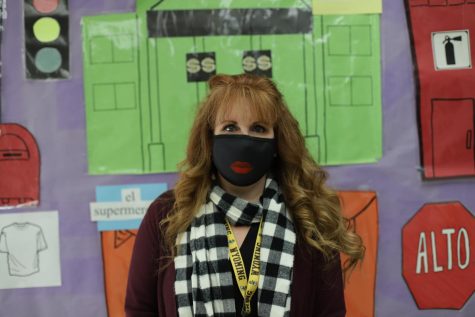
Spanish teacher Ms. Karen Kessler owns five masks, one for each day of the school week. Her masks are made of cloth, and “some are double-layered, but I don’t wear multiple masks at once,” she said.
She has gotten masks from Stark’s Vacuums as well as from Etsy. When buying them, Ms. Kessler is “looking for something that I can somewhat breathe in, functionality, and that it, you know, fits but doesn’t suffocate,” she said.
Ms. Kessler picks which mask to wear based on “whatever’s clean,” she said, “you’d think I would coordinate them with outfits, but no.”
Not only are masks typically “suffocating,” said Ms. Kessler, but “[they] take away facial expression and when you’re speaking in [a] foreign language, kids need to see your face.” She acknowledges that there are clear masks, “but they fog up, there’s no perfect science to that,” she said.

Junior Rodolfo Lopez chooses which to wear from his collection of over 15 masks by “whichever one is most comfortable,” he said. He defines comfortable as “the elastic doesn’t hurt my ears after wearing it for [an] extended period of time.”
Lopez “usually” incorporates his masks into whatever he’s wearing, he said. As for where he’s gotten his mask from, he is unsure because “usually, my parents buy them for me,” he said.
The worst part of everybody wearing a mask for Lopez is “not really fully seeing other people’s faces,” he said.
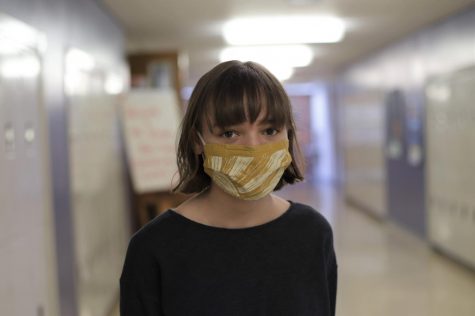
For junior Emma Olson, wearing the mask pictured above “allows me to be creative and have some sort of self-expression though wearing a mask, which is really important and necessary right now,” she said.
“I actually made this mask,” Olson explained. She used a linoleum block printing technique to create the design, printed the design onto the fabric, and then learned how to sew a “basic accordion fold mask,” she said.
Making masks has been “something I’ve done since summer,” said Olson, “it’s just something that I’ve found enjoyment out of doing, out of having to wear a mask.”
Olsen owns “probably four or five [masks],” she said. “I have a little bit of color variety… so I’ll try to match [the mask] with my outfit, but it usually depends on which one’s clean.”


